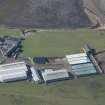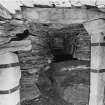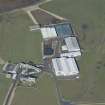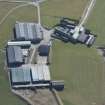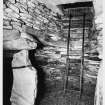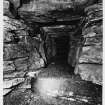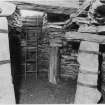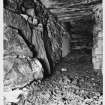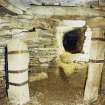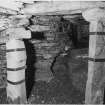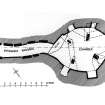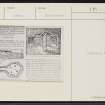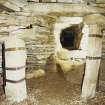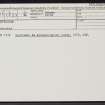Rennibister
Human Remains(S) (Period Unknown), Souterrain (Prehistoric)
Site Name Rennibister
Classification Human Remains(S) (Period Unknown), Souterrain (Prehistoric)
Canmore ID 2081
Site Number HY31SE 3
NGR HY 3973 1260
Datum OSGB36 - NGR
Permalink http://canmore.org.uk/site/2081
- Council Orkney Islands
- Parish Firth
- Former Region Orkney Islands Area
- Former District Orkney
- Former County Orkney
HY31SE 3 3973 1260.
(HY 3971 1259) This earth-house, discovered in 1926, has been partly reconstructed by the Ministry of Public Buildings and Works (MOPBW) and the interior is reached through the roof of the main compartment.
When originally examined, the floor of the main chamber was covered with human bones in considerable quantity, of adults and children of both sexes. The only other find was an ox-scapula 'spade'.
H Marwick 1927; RCAHMS 1946; H Marwick 1952; V G Childe and W D Simpson 1961.
Earth-house, as described and illustrated above.
Surveyed at 1/2500.
Visited by OS (NKB) 22 April 1966.
Publication Account (1996)
An interesting example of a modern farm on exactly the same spot as an iron-age farm, Rennibister lies close to the shore with access to a fertile area of land which has attracted settlement since neolithic times as demonstrated by three chambered cairns. Another earth-house was found in the 19th century near Saverock, between Rennibister and Grain. The presence of the earthhouse at Rennibister was unsuspected until 1926 when its roof gave way beneath the weight of a threshing-machine passing overhead, and a modern hatch and ladder now allow entry through the roof into the chamber. Original access was down the narrow lintelled passage opening into the opposite end of the chamber, though with a width and height of only about 0.7m, it can never have been easy. The chamber is oval, its originally cor belied roof supported on four free-standing stone pillars, and its walls are furnished with five small recesses, one divided by a stone shelf. When it was first discovered, the end of the passage was filled with shells and domestic refuse, and a jumbled mass of human bones on the floor of the chamber proved to be the remains of six adults and twelve children. The fact that the skeletons were disarticulated implies that it was as bones rather than bodies that they were placed in the earth-house, presumably having originally been buried elsewhere, but it is not known why, or when, this was done.
Information from ‘Exploring Scotland’s Heritage: Orkney’, (1996).
Orkney Smr Note
When originally examined the floor of the main chamber was covered with human bones in considerable quantity, of adults and children of both sexes. The only other find was an ox-scapula 'spade'. [R1]
This earthhouse at Rennibister lies immediately behind the farm-house at the entrance to the steading. It was accidently discovered on the 12th November 1926 when the roof of the structure gave way beneath the weight of a threshing machine. The monuments chamber has been completely cleared out and partly reconstructed, the interior now being reached through an opening in the roof of the main compartment. The compartment is roughly hexagonal, with its major axis running NW and SE. It is about 11ft 3in long by 8.5ft wide. It is about 5ft high in the centre. Further support for the roof has been provided by four freestanding pillars arranged in a squarish formation. The chamber was originally entered from the NW by a narrow passage. The outer end of the passage opens into a well-like space or hatchway. The chamber is provided at the wall angles with five small recesses or aumbries of various sizes.[R2] [R3]
An interesting example of a modern farm on exactly the same spot as an iron age farm, Rennibister lies close to the shore with access to a fertile area of land which has attracted settlement since neolithic times as demonstrated by the three chambered cairns. Another earth-house was found in the c19th near Saverock,
between Rennibister and Grain. The presence of the earth-house at Rennibister was unsuspected until 1926 when its roof gave way beneath the weight of a threshing machine passing overhead, and a modern hatch and
ladder now allow entry through the roof in to the chamber. Original access was down the narrow lintelled passage opening into the opposite end of the chamber, though with a width and height of only about 0.7m, it can never have been easy. The chamber is oval, its originally corbelled roof supported on four freestanding stone pillars, and its walls are finished with five small recesses, one divided by a stone shelf. When it was first
discovered, the end of the passage was filled with shells and domestic refuse, and a jumbled mass of human bones on the floor of the chamber proved to be the remains of six adults and twelve children. The fact that the skeletons were disarticulated implies that it was as bones rather than bodies that they were placed in the earth-house, presumably having originally been buried elsewhere but it is not known why, or when, this was done.
Information from Orkney SMR [n.d.]
























